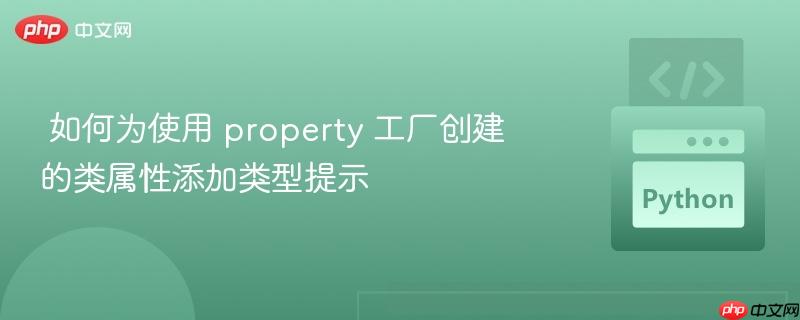
本文探讨了如何在使用工厂方法动态创建 python 类属性(特别是 property)时,正确地添加类型提示。重点在于解决 `mypy` 和 `pyright` 等类型检查工具将这些属性识别为 `any` 类型的问题,并提供了一种使用泛型 `property` 类来保留类型信息的方法,确保代码的类型安全和可维护性。
在使用 Python 创建接口类时,我们经常会遇到需要动态生成 property 的情况,以避免代码重复。然而,使用工厂方法创建 property 时,类型检查器 (如 `mypy` 和 `pyright`) 可能会无法正确推断属性的类型,将其标记为 `Any`。这会导致类型检查的失效,降低代码的可维护性和可靠性。 ### 问题分析 考虑以下代码示例,它使用 `property_factory` 函数来创建类的 property: ```python from __future__ import annotations class Interface: def property_factory(name: str) -> property: """Create a property depending on the name.""" @property def _complex_property(self: Interface) -> str: # Do something complex with the provided name return name @_complex_property.setter def _complex_property(self: Interface, _: str): pass return _complex_property foo = property_factory("foo") # Works just like an actual property bar = property_factory("bar") def main(): interface = Interface() interface.foo # Is of type '(variable) foo: Any' instead of '(property) foo: str' if __name__ == "__main__": main()在这个例子中,Interface.foo 和 Interface.bar 应该被识别为 (property) foo/bar: str,但实际上却被标记为 (variable) foo/bar: Any。这是因为 property_factory 的返回类型被声明为 property,而 property 本身不是泛型的,无法携带关于 getter 方法返回类型的具体信息。
为了解决这个问题,我们可以创建一个泛型的 Property 类,它是 property 的子类,并且可以携带类型信息。
from typing import Any, Generic, TypeVar, overload, cast, Callable
T = TypeVar('T') # The return type
I = TypeVar('I') # The outer instance's type
class Property(property, Generic[I, T]):
def __init__(
self,
fget: Callable[[I], T] | None = None,
fset: Callable[[I, T], None] | None = None,
fdel: Callable[[I], None] | None = None,
doc: str | None = None
) -> None:
super().__init__(fget, fset, fdel, doc)
@overload
def __get__(self, instance: None, owner: type[I] | None = None) -> Callable[[I], T]:
...
@overload
def __get__(self, instance: I, owner: type[I] | None = None) -> T:
...
def __get__(self, instance: I | None, owner: type[I] | None = None) -> Callable[[I], T] | T:
return cast(Callable[[I], T] | T, super().__get__(instance, owner))
def __set__(self, instance: I, value: T) -> None:
super().__set__(instance, value)
def __delete__(self, instance: I) -> None:
super().__delete__(instance)这个 Property 类是一个泛型类,它接受两个类型参数:I 代表外部实例的类型,T 代表 getter 方法的返回类型。通过使用 Generic[I, T],我们可以将 property 的类型信息传递给类型检查器。
现在,我们可以修改原始代码,使用这个泛型的 Property 类:
from collections.abc import Callable
Getter = Callable[['Interface'], str]
Setter = Callable[['Interface', str], None]
def complex_property(name: str) -> tuple[Getter, Setter]:
def _getter(self: Interface) -> str:
# Do something complex with the provided name
return name
def _setter(self: Interface, value: str) -> None:
# Do something when setting the property
pass
return _getter, _setter
class Interface:
foo = Property(*complex_property("foo"))在这个修改后的代码中,Interface.foo 现在被正确地识别为 (Interface) -> str,这意味着类型检查器可以正确地推断出该属性的类型,从而进行更有效的类型检查。
为了验证解决方案的有效性,我们可以使用 mypy 或 pyright 等类型检查工具进行检查。以下是一些示例代码和预期结果:
instance = Interface()
reveal_type(Interface.foo) # mypy => (Interface) -> str
# pyright => (Interface) -> str
reveal_type(instance.foo) # mypy + pyright => str
instance.foo = 42 # mypy => error: Incompatible types in assignment
# pyright => error: "Literal[42]" is incompatible with "str" ('foo' is underlined)
instance.foo = 'lorem' # mypy + pyright => fine这些示例表明,使用泛型 Property 类后,类型检查器可以正确地识别属性的类型,并且可以在类型不匹配时发出错误提示,从而提高代码的质量和可靠性。
通过创建一个泛型的 Property 类,我们可以有效地解决在使用工厂方法动态创建 Python 类属性时,类型检查器无法正确推断属性类型的问题。这种方法可以提高代码的可维护性和可靠性,并确保类型检查的有效性。
注意事项:
通过遵循这些步骤,你可以更好地利用 Python 的类型提示系统,编写更健壮、更易于维护的代码。
以上就是如何为使用 property 工厂创建的类属性添加类型提示的详细内容,更多请关注php中文网其它相关文章!

每个人都需要一台速度更快、更稳定的 PC。随着时间的推移,垃圾文件、旧注册表数据和不必要的后台进程会占用资源并降低性能。幸运的是,许多工具可以让 Windows 保持平稳运行。

Copyright 2014-2025 https://www.php.cn/ All Rights Reserved | php.cn | 湘ICP备2023035733号